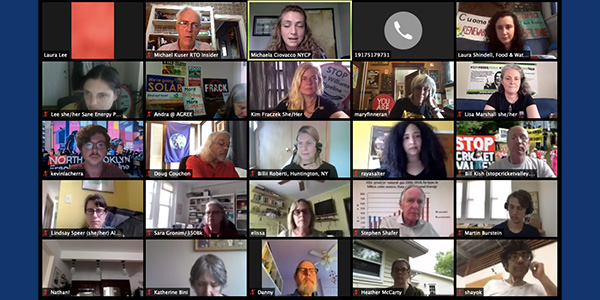More than 130 New Yorkers gathered in an online forum Thursday for a “people’s hearing” organized by nearly a dozen environmental groups to protest the possibility of National Grid increasing the state’s supply of natural gas by adding vaporizing capacity, trucking in compressed natural gas and other measures.
“This people’s hearing marks an unprecedented coming together of campaigns and minds to tackle getting off fracked gas and moving to renewables, first by focusing on the upcoming June 11 decision by the [New York] Public Service Commission on National Grid’s plan to meet downstate energy demand,” said Michaela Ciovacco of New Yorkers for Clean Power (NYCP).
The group helped organize the event as a member of Renewable Heat Now, along with Sane Energy Project, Alliance for a Green Economy, Mothers Out Front, Sierra Club, Food & Water Action, NY Renews, Stop the Williams Pipeline Coalition, Heatsmart Tompkins and No North Brooklyn Pipeline.
New Jersey and New York regulators two weeks earlier denied permits for the Williams pipeline, also known as the Northeast Supply Enhancement (NESE) project, which would have carried natural gas from Pennsylvania across New York Harbor into the Rockaways, Queens.
“Neither the utility nor the Public Service Commission have scheduled a public hearing, so that’s why we came together,” Ciovacco said.
The organizers claimed that any increase in fossil fuel usage would violate the spirit and the letter of the state’s Climate Leadership and Community Protection Act, signed into law last July. It mandates that 70% of the state’s electricity come from renewable resources by 2030 and that generation be 100% carbon-free by 2040. (See Cuomo Sets New York’s Green Goals for 2020.)
Conflicting State Policies
National Grid spokesperson Karen Young told RTO Insider that a May 8 press release detailed how the company has been fulfilling its 2019 agreement with the PSC to propose long-term solutions for downstate gas supply and demand.
The company’s “no-infrastructure” option includes reducing gas demand through incremental energy efficiency measures, demand response and electrification.
The company this past winter and spring held six public meetings attended by more than 800 people, and altogether more than 7,500 public comments have been filed with the PSC.
National Grid found itself at odds with Gov. Andrew Cuomo last November when he criticized a company moratorium on new gas hook-ups that the company attributed to supply concerns. Cuomo issued a letter demanding that its gas subsidiaries connect all customers for whom it had denied service under the moratorium or he would seek “to revoke National Grid’s certificate to operate its downstate gas franchise.” (See National Grid Vows to Expand NY Gas Service.)
PSC Chair John B. Rhodes on Oct. 11 had signed an order forcing National Grid subsidiaries Brooklyn Union Gas (KEDNY) and KeySpan Gas East (KEDLI) to connect 1,100 of 3,300 customers that had been denied natural gas service connections (Case 19-G-0678). KEDNY has approximately 1.2 million customers, and KEDLI has 590,000 customers on Long Island.
Brooklyn resident Jackie Weisberg addressed her comments during the online protest to Cuomo: “I oppose the National Grid fracked gas proposal because these pipelines are like the COVID-19 virus. They are insidiously infecting our communities. Selling us the so-called benefits of fracked gas is not what we need now, or ever. They have no business continuing the work in North Brooklyn [on the Metropolitan Natural Gas Reliability Project], and they are opposed in Connecticut and elsewhere.”
Young said “the Metropolitan Natural Gas Reliability Project is a system integrity project, it’s not one of the long-term capacity solutions — it does not bring additional supply to New York.”
Eyes of the PSC
In its Nov. 26, 2019, agreement with National Grid, the PSC mandated that an independent monitor submit quarterly reports to keep it apprised of the company’s progress in finding ways to provide gas service to all its customers in downstate New York.
The monitor’s third report, filed May 26, said that it attended all the public meetings and afterward began “monitoring the key executive meetings conducted internally at National Grid to address its compliance.”
In assessing the company’s development of long-term solutions, the report said it reviewed implementation of energy efficiency and demand response and “makes no formal findings or recommendations but provides observations regarding National Grid’s progress and positions.”
The monitor highlighted National Grid in April having hired Ernst & Young to review the company’s “development of natural gas demand scenarios and the identification and selection of options to meet demand.”
National Grid’s analysis turns on a design day standard, currently a 24-hour period with an average temperature of 0 degrees Fahrenheit in Central Park. The last design day was in 1934, and many public comments questioned the suitability of that standard today, the monitor said.
“To illustrate the point, National Grid has determined that the 24-hour period with the coldest average temperature in Central Park over the last 30 years was approximately 4 degrees F and took place in 1994,” the report said.
The monitor faulted National Grid for being too conservative on the one hand and too extreme on the other for assuming the increased reliance on compressed natural gas trucking through 2035, despite the practice raising “risk, cost and reliability questions.”
“Based on forecast figures provided by National Grid to the monitor, several more middle-ground approaches … indicate possible opportunities to move forward that are less stark than simply choosing between NESE or the no-infrastructure options,” the monitor said.
It also said that the company is not fully accounting for the reduced demand impact from the current pandemic, despite its own reporting that the reduced demand added a year to the predicted time when demand will exceed supply, to the winter of 2022/23.






